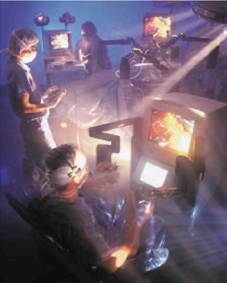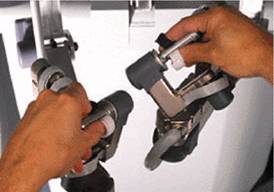





Published on Nov 30, 2023
The field of surgery is entering a time of great change, spurred on by remarkable recent advances in surgical and computer technology. Computer-controlled diagnostic instruments have been used in the operating room for years to help provide vital information through ultrasound, computer-aided tomography (CAT), and other imaging technologies.
Only recently have robotic systems made their way into the operating room as dexterity-enhancing surgical assistants and surgical planners, in answer to surgeons' demands for ways to overcome the surgical limitations of minimally invasive laparoscopic surgery.
The Robotic surgical system enables surgeons to remove gallbladders and perform other general surgical procedures while seated at a computer console and 3-D video imaging system acrossthe room from the patient. The surgeons operate controls with their hands and fingers to direct a robotically controlled laparoscope. At the end of the laparoscope are advanced, articulating surgical instruments and miniature cameras that allow surgeons to peer into the body and perform the procedures.
Now Imagine : An army ranger is riddled with shrapnel deep behind enemy lines. Diagnostics from wearable sensors signal a physician at a nearby mobile army surgical hospital that his services are needed urgently. The ranger is loaded into an armored vehicle outfitted with a robotic surgery system. Within minutes, he is undergoing surgery performed by the physician, who is seated at a control console 100 kilometers out of harm's way.
The patient is saved. This is the power that the amalgamation of technology and surgical sciences are offering Doctors. Just as computers revolutionized the latter half of the 20th century, the field of robotics has the potential to equally alter how we live in the 21st century. We've already seen how robots have changed the manufacturing of cars and other consumer goods by streamlining and speeding up the assembly line.
We even have robotic lawn mowers and robotic pets now. And robots have enabled us to see places that humans are not yet able to visit, such as other planets and the depths of the ocean. In the coming decades, we will see robots that have artificial intelligence,coming to resemble the humans that create them. They will eventually become self-aware and conscious, and be able to do anything that a human can. When we talk about robots doing the tasks of humans, we often talk about the future, but the future of Robotic surgery is already here.
Robotic surgery is the latest technological advancement that introduces the robotic technology in the field of surgery. Only recently have robotic systems made their way into the operating room as dexterity-enhancing surgical assistants and surgical planners, in answer to surgeons' demands for ways to overcome the surgical limitations of minimally invasive laparoscopic surgery.

This system enables surgeons to remove gallbladders and perform other general surgical procedures while being seated at a computer console and 3-D video imaging system across the room from the patient. The surgeons operate controls with their hands and fingers to direct a robotically controlled laparoscope. At the end of the laparoscope are advanced articulating surgical instruments and miniature cameras that allow surgeons to peer into the body and perform the procedures.
This system and other robotic devices developed or under development have the potential to revolutionize surgery and the operating room. They provide surgeons with the precision and dexterity necessary to perform complex, minimally invasive surgical (MIS) procedures, such as beating-heart single- or double-vessel bypass and neurological, orthopedic, and plastic surgery, among many other future applications. Robotic surgery has broadened the scope and increased the effectiveness of minimally invasive surgery (MIS); improved patient outcomes; and created a safer, more efficient, and more cost-effective operating room. These Robotic systems will one day be applicable to all surgical specialties.
The Laparoscopic surgery—in which instruments are inserted through small incisions—has been used by surgeons whenever possible. Patients are less traumatized, require shorter hospital stays, and heal faster than with conventional surgery. Laparoscopic instruments are mainly limited to scissors and staplers to close incisions or attach blood vessels. It also has graspers to manipulate tissue. The instruments enter the body through a long tube; a video image from a tiny camera called an endoscope poked through another incision guides the surgeon. For a relatively simple procedure like gallbladder removal, the tools work well enough. But surgeons can't use the instruments to perform complicated tasks like suturing and knot tying. Because of these limitations, most operations can't be performed endoscopically.
Robotic surgery uses laparoscopic tools—including miniature robotic hands with the dexterity to tie knots. The reason the surgeons have to cut a person open is to get their hands in there. The surgeons like to get their hands around the organs, to palpate them. Robotic surgery provides with little instruments in there that let the surgeons feel as if they are working with their hands in a normal procedure, and hence avoiding a bigger incision.
The Robotic surgical system consists of a pencil-size joystick (one each for the surgeon's right and left hands), a computer, and right-hand and left-hand end effectors—the robotic instruments that snake into the body to perform the actual surgery. Each hydraulically powered end effector consists of a single digit, three to four inches long and lesshan half an inch wide. It has four joints that rotate, swivel, and swing back and forth and a grasper at the end. The result: A finger that functions like an entire hand.
The surgery is completely anthropomorphic. If the hand moves in, the instrument moves in; if the hand moves to the right, the instrument moves to the right. The system also has force feedback, which relays to doctors the response of muscles and other tissues to their actions. The feedback makes the procedure feel more like normal surgery. The system also has tactile sensors that will transmit the feel of tissue to the surgeon's fingertips.

Surgery now uses robotic and image processing systems in order to interactively assist the medical team, both in planning the surgical intervention, and in its execution. This new technique enhances the quality of surgical procedures by minimizing their side effects (smaller incisions, lesser trauma, and more precision...), thus increasing patient benefit while decreasing the surgical cost. These techniques are being successfully introduced in several areas of surgery: neurosurgery, orthopedics, micro-surgery, cardiovascular and general surgery etc.
WHY GO FOR A ROBOTIC SURGERY?
The advantages of using robotic-assisted surgery are many:
• They bring down the cost of the operation.
• The patient has a faster recovery time because there is fewer traumas.
• There is less chance of complication.
• The doctor can see better through fiber optics than with his or her regular sight.
• Robotic arms do not suffer fatigue or tremors as do the human hand.
This category of application, command and control usually requires relatively low bandwidth. This appears to be the case for the control of medical devices as well. The exception is the robotic surgery application which will require not just the transmission of control signals, but also the transmission of real-time motion images at VMS tape quality (about 75 Mbits/second).
Latency is the essential factor in these applications as the overshoot of a controlled parameter could result in a life-threatening situation. It has been suggested that the latency of the human nervous system is under 15 msec, and therefore the latency of the control system should be under 10 msec.
These applications may involve the transmission of real patient data which the patient may consider sensitive or control signal which, if tampered with, could cause life threatening situations. They require a high level of transmission security to be sure that they cannot be viewed or altered during transmission.
Reliability: The network must be as close to 100% reliable as possible as lack of reliability could result in life threatening situations.
This group of applications tend to be point to point applications and so will initially not require scalability. However, if viewed as a successful telemedicine applications, the bandwidth available on the network should be scalable so that the capacity can be increased in the future in response to potential increases in demand. In the case of robotic surgery, future additional interactive monitoring sites may be added so that such tele-surgery can also serve a useful teaching function which will require a degree of network scalability.
| Are you interested in this topic.Then mail to us immediately to get the full report.
email :- contactv2@gmail.com |